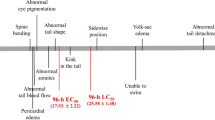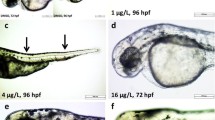Abstract
Extremely low-frequency (ELF) magnetic field (MF), as a widespread ecological factor, has an influence on all living beings. In the present study, biological effects of ELF-MF on the development of zebrafish (Danio rerio) embryos were investigated. Fertilized embryos were divided into seven groups as control, sham, and five experimental groups. Embryos of experimental groups were continuously exposed to 50-Hz sinusoidal MF with intensities of 30, 100, 200, 400, and 800 μT for 96 h. The sham group was treated as the experimental groups, but without any ELF-MF exposure. The control group was not subjected to anything. The results showed that ELF-MF exposure caused delayed hatching and decreased heart rate at the early developmental stages of zebrafish embryos, whereas no significant differences in embryo mortality and abnormality were observed. Moreover, acridine orange staining assays showed notable signals of apoptosis mainly in the ventral fin and spinal column. The transcription of apoptosis-related genes (caspase-3, caspase-9) was significantly upregulated in ELF-MF-exposed embryos. In conclusion, the overall results demonstrated that ELF-MF exposure has detrimental effects on the embryonic development of zebrafish by affecting the hatching, decreasing the heart rate, and inducing apoptosis, although such effects were not mortal threat. The results also indicate that zebrafish embryos can serve as a reliable model to investigate the biological effect of ELF-MF.






Similar content being viewed by others
References
Chebotareva YV, Izyumov YG, Krylov V (2009) The effect of an alternating electromagnetic field upon early development in roach (Rutilus rutilus: Cyprinidae, cypriniformes). J Ichthyol 49(5):409–415
Organization WH (2007) Electromagnetic fields and public health. Fact Sheet 304
Infante-Rivard C, Deadman JE (2003) Maternal occupational exposure to extremely low frequency magnetic fields during pregnancy and childhood leukemia. Epidemiology 14(4):437–441
Kheifets L, Bowman JD, Checkoway H et al (2009) Future needs of occupational epidemiology of extremely low frequency electric and magnetic fields: review and recommendations. Occup Environ Med 66(2):72–80
Graham JH, Fletcher D, Tigue J, McDonald M (2000) Growth and developmental stability of Drosophila melanogaster in low frequency magnetic fields. Bioelectromagnetics 21(6):465–472
Chung MK, Kim JC, Myung SH, Lee DI (2003) Developmental toxicity evaluation of ELF magnetic fields in Sprague-Dawley rats. Bioelectromagnetics 24(4):231–240
Nazıroğlu M, Yüksel M, Köse SA, Özkaya MO (2013) Recent reports of Wi-Fi and mobile phone-induced radiation on oxidative stress and reproductive signaling pathways in females and males. J Membr Biol 246(12):869–875
Çetin H, Naziroglu M, Çelik Ö, et al (2014) Liver antioxidant stores protect the brain from electromagnetic radiation (900 and 1800 MHz)-induced oxidative stress in rats during pregnancy and the development of offspring. J Matern Fetal Neo M (0):1-6 doi: 10.3109/14767058.2014.898056
Kahya MC, Nazıroğlu M, Çiğ B (2014) Selenium reduces mobile phone (900 MHz)-induced oxidative stress, mitochondrial function, and apoptosis in breast cancer cells. Biol Trace Elem Res 160(2):285–293
Huuskonen H, Juutilainen J, Komulainen H (2001) Development of preimplantation mouse embryos after exposure to a 50 Hz magnetic field in vitro. Toxicol Lett 122(2):149–155
Özorak A, Nazıroğlu M, Çelik Ö et al (2013) Wi-Fi (2.45 GHz)-and mobile phone (900 and, 1800 MHz)-induced risks on oxidative stress and elements in kidney and testis of rats during pregnancy and the development of offspring. Biol Trace Elem Res 156(1–3):221–229
Li SS, Zhang ZY, Yang CJ, Lian HY, Cai P (2013) Gene expression and reproductive abilities of male Drosophila melanogaster subjected to ELF–EMF exposure. Mutat Res-Gen Toxicol En 758(1):95–103
Jennings J, Chen D, Feldman D (2008) Transcriptional response of dermal fibroblasts in direct current electric fields. Bioelectromagnetics 29(5):394–405
Juutilainen J (2005) Developmental effects of electromagnetic fields. Bioelectromagn Suppl 7:S107–S115
Long Y, Li L, Li Q, He X, Cui Z (2012) Transcriptomic characterization of temperature stress responses in larval zebrafish. PLoS ONE 7(5):e37209
Koh EK, Ryu BK, Jeong DY et al (2008) A 60-Hz sinusoidal magnetic field induces apoptosis of prostate cancer cells through reactive oxygen species. Int J Radiat Biol 84(11):945–955
Terol F, Panchon A (1995) Exposure of domestic quail embryos to extremely low frequency magnetic fields. Int J Radiat Biol 68(3):321–330
Lotfi A, Narimani-Rad M (2012) Effect of exposure to extremely low frequency electromagnetic fields (50 Hz, 0.5 mT) during incubation on hatchability, T3 and T4 levels in newly-hatched chicks. Asian J Anim Vet Adv 7:733–738
Formicki K, Winnicki A (1998) Reactions of fish embryos and larvae to constant magnetic fields. Ital J Zool 65:479–482
Hardy K (1997) Cell death in the mammalian blastocyst. Mol Hum Reprod 3(10):919–925
Levy R, Cordonier H, Czyba J, Guerin J (2001) Apoptosis in preimplantation mammalian embryo and genetics. Ital J Anat Embryol 106(2 Suppl 2):101
Lahijani MS, Tehrani DM, Fereydouni N (2012) Effects of 50 Hz extremely low frequency sinusoidal magnetic fields on the apoptosis of the hearts of preincubated chicken embryos at different levels of developments. Int J Radiat Biol 89(4):234–242
Borhani N, Rajaei F, Salehi Z, Javadi A (2011) Analysis of DNA fragmentation in mouse embryos exposed to an extremely low-frequency electromagnetic field. Electromagn Biol Med 30(4):246–252
Lee JS, Ahn SS, Jung KC, Kim YW, Lee SK (2004) Effects of 60 Hz electromagnetic field exposure on testicular germ cell apoptosis in mice. Asian J Androl 6(1):29–34
Kim YW, Kim HS, Lee JS et al (2009) Effects of 60 Hz 14 μT magnetic field on the apoptosis of testicular germ cell in mice. Bioelectromagnetics 30(1):66–72
Westerfield M (1995) The zebrafish book: a guide for the laboratory use of zebrafish (Danio rerio). University of Oregon, Eugene
Reitz JR, Milford FJ, Christy RW (2008) Foundations of electromagnetic theory. Addison-Wesley Publishing Company, New Jersey
Misakian M, Sheppard AR, Krause D, Frazier ME, Miller DL (1993) Biological, physical, and electrical parameters for in vitro studies with ELF magnetic and electric fields: a primer. Bioelectromagnetics 14(S2):1–73
Chan P, Cheng S (2003) Cadmium-induced ectopic apoptosis in zebrafish embryos. Arch Toxicol 77(2):69–79
Deng J, Liu C, Yu L, Zhou B (2010) Chronic exposure to environmental levels of tribromophenol impairs zebrafish reproduction. Toxicol Appl Pharmacol 243(1):87–95
Gye MC, Park CJ (2012) Effect of electromagnetic field exposure on the reproductive system. Clin Exp Reprod Med 39(1):1–9
Mirabolghasemi G, Azarnia M (2002) Developmental changes in Drosophila melanogaster following exposure to alternating electromagnetic fields. Bioelectromagnetics 23(6):416–420
Cameron I, Hunter K, Winters W (1985) Retardation of embryogenesis by extremely low frequency 60 Hz electromagnetic fields. Physiol Chem Phys Med NMR 17(1):135–138
Zimmerman S, Zimmerman AM, Winters WD, Cameron IL (1990) Influence of 60-Hz magnetic fields on sea urchin development. Bioelectromagnetics 11(1):37–45
Berridge MJ, Lipp P, Bootman MD (2000) The versatility and universality of calcium signalling. Nat Rev Mol Cell Bio 1(1):11–21
Zhao YL, Yang JC, Zhang YH (2008) Effects of magnetic fields on intracellular calcium oscillations. Eng Med Biol Soc 2124-2127
Ghazizadeh V, Nazıroğlu M (2014) Electromagnetic radiation (Wi-Fi) and epilepsy induce calcium entry and apoptosis through activation of TRPV1 channel in hippocampus and dorsal root ganglion of rats. Metab Brain Dis 1–13
Sert C, Söker S, Deniz M, Nergiz Y (2011) Intracellular Ca2+ levels in rat ventricle cells exposed to extremely low frequency magnetic field. Electromagn Biol Med 30(1):14–20
Malmivuo J, Plonsey R (1995) Bioelectromagnetism: principles and applications of bioelectric and biomagnetic fields. Oxford University, New York
Walleczek J, Budinger TF (1992) Pulsed magnetic field effects on calcium signaling in lymphocytes: dependence on cell status and field intensity. FEBS Lett 314(3):351–355
Yabu T, Kishi S, Okazaki T, Yamashita M (2001) Characterization of zebrafish caspase-3 and induction of apoptosis through ceramide generation in fish fathead minnow tailbud cells and zebrafish embryo. Biochem J 360:39–47
Yamashita M (2003) Apoptosis in zebrafish development. Comp Biochem Phys B 136(4):731–742
Yabu T, Todoriki S, Yamashita M (2001) Stress-induced apoptosis by heat shock, UV and B-ray irradiation in zebrafish embryos detected by increased caspase activity and whole-mount TUNEL staining. Fisheries Sci 67:333–340
Cai G, Zhu J, Shen C et al (2012) The effects of cobalt on the development, oxidative stress, and apoptosis in zebrafish embryos. Biol Trace Elem Res 150(1–3):200–207
Cohen G (1997) Caspases: the executioners of apoptosis. Biochem J 326:1–16
Gavoçi E, Zironi I, Remondini D et al (2013) ELF magnetic fields tuned to ion parametric resonance conditions do not affect TEA-sensitive voltage-dependent outward K+ currents in a human neural cell line. Bioelectromagnetics 34(8):579–588
Tola EN, Mungan MT, Uğuz AC, Naziroğlu M (2013) Intracellular Ca2+ and antioxidant values induced positive effect on fertilisation ratio and oocyte quality of granulosa cells in patients undergoing in vitro fertilisation. Reprod Fert Dev 25(5):746–752
Acknowledgments
This study was supported by grants from the Specialized Research Fund for the Doctoral Program of Higher Education (No. 20130142110016), Science and Technology Project of State Grid Corporation of China (No. GY71-13-057), Technology Innovation Fund, and Independent Innovation Fund of Huazhong University of Science and Technology. The authors extend their gratitude to the Wuhan High Voltage Institute for guiding the creation of the ELF-MF-generating equipment.
Conflict of Interest
The authors indicate no potential conflicts of interest.
Author information
Authors and Affiliations
Corresponding author
Rights and permissions
About this article
Cite this article
Li, Y., Liu, X., Liu, K. et al. Extremely Low-Frequency Magnetic Fields Induce Developmental Toxicity and Apoptosis in Zebrafish (Danio rerio) Embryos. Biol Trace Elem Res 162, 324–332 (2014). https://doi.org/10.1007/s12011-014-0130-5
Received:
Accepted:
Published:
Issue Date:
DOI: https://doi.org/10.1007/s12011-014-0130-5




